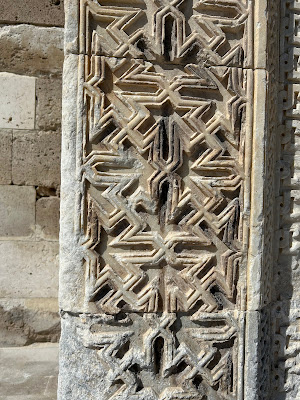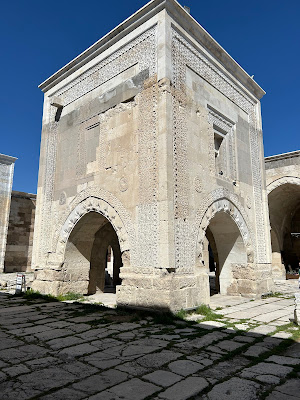The Sultanhani Caravaserai, built in A.D. 1229 in Konya, is a rare instance of a Seljuk building which remains intact. The Seljuk Empire, as you might recall, had an inland empire in Anatolia prior to that of Ottoman Turks, reigning over a large area of the now Middle East and Central Asia from A.D. 1037 to 1194, reduced in size from A.D. 1194 to their final defeat in A.D. 1308.

The purpose of the caravanserai was to encourage trade - in this case, trade along the Silk Road that led from China to the Mediterranean and eventually Western Europe and Africa. Many traders did not make the entire trip across Asia; they would stop at trading posts like this to exchange goods for certain portions of the route. Thus, the caravanserai became a meeting point of different cultures and peoples.
A caravanserai (or caravanseray) was a sort of roadside in for traders and travelers. In the case of the Sultanhani Caravanserai, strong walls made both for protection from the elements as well as protection from potential thieves and robbers.
(One of the entry gates)
The Caravanserai was divided into two main parts, an outer part consisting of an open space, an arcade on one side and a series of small rooms on the other, and a small building in the center (below) which was a small mosque.
The arcade:
An entry door to one of the rooms:
An interior room. These could serve as storage rooms, quarters, or work areas.
Another view of the mosque. This is the oldest square mosque in Turkey.
Another interior:













Most interesting TB, maybe high = secure? Or the presence of the army provided security?
ReplyDeleteProbably, Nylon12. Keep in mind as well that given the times, the greater risk was likely hit and run raids and thieves rather than full on military maneuvers. Walls like this would likely have been enough to keep those sorts of things at bay.
DeleteI never thought of this until this morning, but what kind of hinge hardware did they have back in 1229? Also, I'm assuming they employed some very stout men or animals to open and close the doors. I see people struggle all the time to open much smaller doors on a breezy day!
ReplyDeleteEd, my guess is very simple hardware made by blacksmiths. My guess on the doors is strong backs. Lots and lots of strong backs. Well balanced gates might have helped with that.
DeleteThe architecture is definitely unique, especially some of those doors. It would be interesting to take a peek back in time and see it filled with everyday hustle and bustle.
ReplyDeleteLeigh, even with the tourist in place, it did not give a true sense of what it might have been like. It would indeed be fascinating to see (and smell. I can only imagine the smell.).
Delete